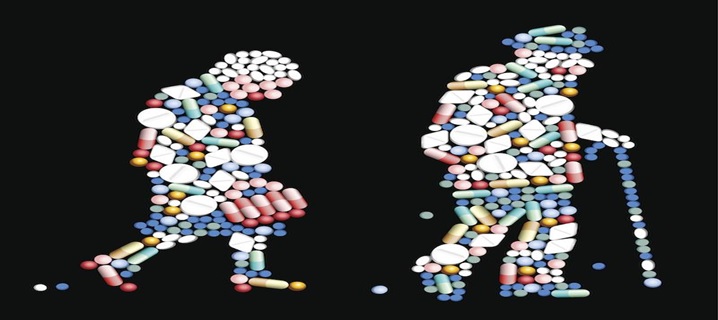Elderly adults taking opioid painkillers are 68% more likely to be hospitalized and are 87% more likely to die as those taking over-the-counter pain medication.
By Pam McDonald
My best friend in life, Peggy Hora, presided over a California criminal court for more than 20 years. Early on, she saw the horrendous, devastating impact drug and alcohol abuse had on people and society. She dedicated her career to drug- and other problem-solving courts and became a founder of the therapeutic jurisprudence movement, which offers real help and healing to alcohol and drug addicts.
For some time now, Peggy has been trying to interest me in the opioid epidemic. While I know it’s an important and serious issue, I just didn’t see it as a priority for seniors . . . until I got her latest blog, “Not Your Usual ‘Drug Addicts.’”
Here are some facts we in the senior living industry should know.
The Scope of the Problem
-
While senior citizens make up only 12% of the U.S. population, they take 30% of all prescription medication
-
A 2011 study of Medicare recipients found that about 15% were prescribed an opioid when discharged from the hospital; 3 months post-discharge, 42% were still taking these highly addictive pain medicines
-
Nearly 1/3 of Medicare beneficiaries in 2015 received at least one prescription for such opioids as OxyContin, Vicodin and fentanyl
-
Those receiving these drugs had an average of 5 prescriptions for them
-
In the past 20 years, the rate of opioid-related hospitalization to overuse among seniors has quintupled
-
Approximately 20.6 million Americans have an addiction; 2.6 million of whom are dependent on both alcohol and illicit drugs
-
About 100 people die every day from drug overdoses, a rate that has tripled in the past 20 years
Older Americans and the Opioid Epidemic
According to Peggy, “Oregon doctors pride themselves on being leaders in palliative care – anticipating, preventing and managing pain. They wrote prescriptions for pain relief virtually without a second thought. Then the statistics started rolling in . . .
-
Oregon was declared the state most likely to have seniors hospitalized for opiate misuse.
-
In 2012, Oregon providers handed out nearly 820,000 opioid prescriptions to those 65 and older.
-
That jumped to 1.1 million in 2016, or 1.6 prescriptions per senior.”
In 2016, the CDC issued guidelines for use of opiates in palliative care that recognizes the special issues seniors face.
According to the National Safety Council, “Elderly adults taking opioid painkillers have 4 times as many bone fractures, are 68% more likely to be hospitalized and are 87% more likely to die as those taking over-the-counter pain medication.”
Substance Misuse Issues Specifically for Senior Living
Senior living communities are social, rather than medical, models of care. The communities themselves determine policies about the levels of care they will provide. States set out the requirements for caregiving including staff credentials, skill sets, and training. Operations of individual senior living communities vary tremendously.
While electronic health record platforms, such as MatrixCare® (a Senior Housing Forum partner), could greatly reduce the risk of adverse drug interactions, currently they are a serious concern for senior living, since so many residents take multiple medications.
Leveraging Engagement Technology
More importantly, according to J. Mark Hamilton, Vice President of Enterprise Solutions for MatrixCare, is the opportunity for the community, friends, and family members to reduce the challenge of isolation and depression by leveraging an engagement platform. MatrixCare released its groundbreaking CareCommunity™ engagement platform this summer.
Mark says, “The opportunity for the senior living community is to leverage technology to engage all of the stakeholders in the region they serve. Using the social engagement, health engagement, and community engagement tools built into CareCommunity™, the senior living organization could become the safe and trusted organization supporting the regions older population.
“Imagine the community engagement and marketing opportunities supporting the older population and resident of the near future,” Mark continues. “By branding the CareCommunity™ platform as your regional Baby Boomer engagement and support social network, the senior living organization helps remove the barriers that contribute to isolation, and the escalation of opioid abuse. Who knows, this engagement technology might even reduce the traditional pharmacological ways of managing mood-altering medications.”
With the first wave of 80-year-old Baby Boomers scheduled to hit senior living in less than a decade – ready or not – the opioid epidemic will impact our operations. Is your community prepared to be the first line of defense, looking out for signs of potential opioid dependence? Will it be a knowledgeable resource for senior specific treatment? What role will your community play?
For more information about CareCommunity™, call (866) 469-3766 or
click on the logo below to visit its website.
Click on the button below to download a PDF copy of this article:
MatrixCare® currently is the platform of choice for over 12,000 facility-based care settings, offering purpose-built software systems for skilled nursing facilities, senior living providers, life plan communities (CCRCs), and home health agencies.
Peggy Hora is President and Co-Founder of the Justice Speakers’ Institute, LLC (JSI), where she is a frequent speaker, trainer, consultant, and writer for local, national and international jurisdictions seeking to use the Drug Court model to addresses societal issues.
J. Mark Hamilton is Vice President of Enterprise Solutions at MatrixCare® where he continues to forward his decade’s-old mission of leveraging disruptive technology to help the older population achieve their goals as they age.









